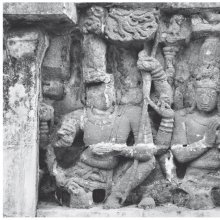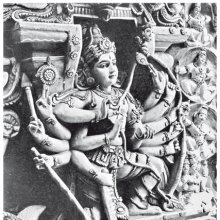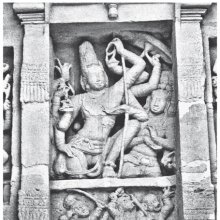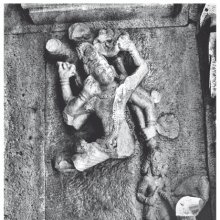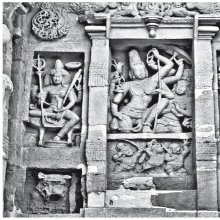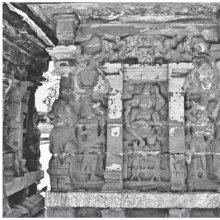Tripurantakamurti, Tripurantaka-murti, Tripurāntakamūrti: 1 definition
Introduction:
Tripurantakamurti means something in Hinduism, Sanskrit. If you want to know the exact meaning, history, etymology or English translation of this term then check out the descriptions on this page. Add your comment or reference to a book if you want to contribute to this summary article.
Images (photo gallery)
(+14 more images available)
In Hinduism
Shilpashastra (iconography)
Source: Shodhganga: Iconographical representations of Śiva (shilpa)1) Tripurāntakamūrti (त्रिपुरान्तकमूर्ति) or simply Tripurāntaka refers to one of the eighteen forms (mūrti) of Śiva mentioned in the Kāraṇāgama (pratimālakṣaṇavidhi-paṭala): the fourth among the Siddhāntaśaivāgamas. The forms of Śiva (e.g., Tripurāntaka-mūrti) are established through a process known as Sādākhya, described as a five-fold process of creation.
2) Tripurāntakamūrti is also listed among the ten forms (mūrti) of Śiva mentioned in the Ajitāgama (under the Raudrarūpa heading): the fifth among the Siddhāntaśaivāgamas.

Shilpashastra (शिल्पशास्त्र, śilpaśāstra) represents the ancient Indian science (shastra) of creative arts (shilpa) such as sculpture, iconography and painting. Closely related to Vastushastra (architecture), they often share the same literature.
See also (Relevant definitions)
Partial matches: Tripurantaka, Murti.
Query error!
Full-text: Tripurantaka, Mahesha.
Relevant text
Search found 5 books and stories containing Tripurantakamurti, Tripurantaka-murti, Tripurāntakamūrti, Tripurāntaka-mūrti; (plurals include: Tripurantakamurtis, murtis, Tripurāntakamūrtis, mūrtis). You can also click to the full overview containing English textual excerpts. Below are direct links for the most relevant articles:
Prayogamanjari and Saivagamanibandhana (Study) (by R. Suthashi)
Description of Tripurantaka-Murti < [Chapter 4 - Anthropomorphic forms of Shiva in Kerala Tantric works]
Kashyapa Shilpa-shastra (study) (by K. Vidyuta)
7. Favourable Directions for Installing the Śiva Mūrtis < [Chapter 3 - Prākāra Lakṣaṇa]
Early Chola Temples (by S. R. Balasubrahmanyam)
Temples in Konerirajapuram (3rd year or earlier) < [Chapter X - Historical Survey]
Pallava period (Social and Cultural History) (by S. Krishnamurthy)
Scheme of Pallava Sculptures < [Chapter 2 - Origin of Sculptural Art—Its Development and Scheme]
The Religion and Philosophy of Tevaram (Thevaram) (by M. A. Dorai Rangaswamy)
Chapter 3.1 - Tripurantaka-murti (burning down of the three castles) < [Volume 2 - Nampi Arurar and Mythology]
